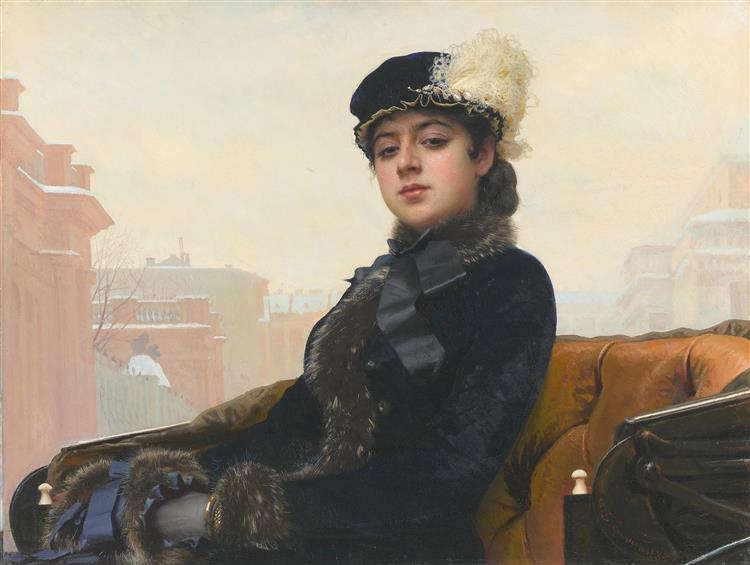Kramskoy – “Unknown”
What is beauty, how beauty and morality correlate, how to merge ethical and aesthetic in art are the subject of constant reflections of Kramskoy. And it is in the context of these reflections that one can understand the meaning of both famous and mysterious “Unknown”. In the legacy of Kramskoy, “Unknown” was destined to become his most popular and famous painting. Appearing at the XI traveling exhibition in 1883 in St. Petersburg, “Unknown” immediately attracted general attention and gave rise to contradictory rumors. Many critics perceived the painting as a work exposing the moral foundations of society. The heroine of the picture was called “one of the fiends of big cities who release despicable women into the streets under their outfits, bought at the price of female chastity”, “a cocotte in a wheelchair.” Tretyakov, apparently, refrained from acquiring the painting, and only in 1925 it ended up in the collection of the Tretyakov Gallery.
The perception of the image of Kramskoy by today’s viewer differs from the perception of his contemporaries. The potential contained in it, its ambiguity later served as the reason for the identification of “Unknown” with Anna Karenina Tolstoy, Nastasya Filippovna Dostoevsky, or the Stranger of Blok. Throughout its long life, Kramskoy’s work acquired an aura of various meanings, acquired a poetic halo.
The position of Kramskoy’s heroine is the position of an outcast, rejected by society and returning him its contempt. The motive for confronting a hostile environment is clearly expressed in the picture. Kramskoy revealed the tragic loneliness of a person whom no one loves and who himself is no longer able to love – a painful desire to assert himself and at the same time vulnerability, inability to contact the world and people. The heroine’s “I” is the “I”, first of all, ready to repulse, to defend. There is a challenge in her gaze, but behind it one can read inner emptiness and brokenness.
The heroine of “Unknown” is attractively beautiful. The artist endowed her with velvety black eyes, a sensual mouth, dark skin with a delicate blush. With great skill, Kramskoy painted a feather on a hat, fluffy fur, blue satin ribbons. “Unknown” is perhaps the only work by Kramskoy, in which he achieved such a tangible, material reliability of the objective world. The lady in the stroller is dressed very fashionably. She is wearing a “Francis” hat (“the last cry” of the 1883 season), “Swedish” gloves and a “Skobelev” coat. This is another hint of the occupation of the lady depicted. “The fashionable outfit of Kramskoy’s heroine testifies to the availability of means to follow the recommendations of magazines, but she cannot say anything about the true position of a lady in society … she does not belong to the high society – the code of unwritten rules excluded strict adherence to fashion in the upper circles of society. In the second half of the 19th century, an aristocratic lady could no longer dictate fashion to the rest – the merchants had a lot of money – this is how a special somewhat old-fashioned style was developed, which distinguishes belonging to the clan aristocracy. “
It can be noted that the image of a woman in a wheelchair does not dissolve in the landscape, is not immersed in the atmosphere of a foggy, frosty winter day, but is placed, as it were, in front of it, which enhances the impression of a challenge, of beauty on display. For the democratic art of the 19th century, beauty is primarily an ethical, not aesthetic, area of the life of the soul, and not of the world of things. Kramskoy strove to peer into the face of Beauty, pondered the question of whether she was good or evil, from God or from the Devil. And yet, for Kramskoy, a man brought up on the ideals of the 1860-1870s, external beauty remains a diabolical obsession and temptation, he perceives the sensual in a woman as the opposite of the spiritual, the feminine appears to be an element hostile to personality, reason, conscience. “Unknown” is an image of evil femininity.
Year of painting: 1883.
Dimensions of the painting: 75.5 x 99 cm.
Material: canvas.
Writing technique: oil.
Genre: portrait.
Style: realism.
Gallery: State Tretyakov Gallery, Moscow, Russia.
